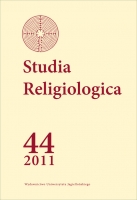Naturalne metody stymulacji doświadczenia ekstazy w praktykach prawosławnych hezychastów
Natural Methods of Stimulation of the Experience of Ecstasy in the Practices of Orthodox Hesychasts
Author(s): Elżbieta Przybył-SadowskaSubject(s): Christian Theology and Religion
Published by: Wydawnictwo Uniwersytetu Jagiellońskiego
Keywords: Religious ecstasy; religious visions; psychosomatic technics; Orthodox Church; Orthodox tradition; Orthodoxy; Orthodox theology; hesychasm; palamism; Gregory Palamas; Evagrius of Pontus; theosis; contemplative prayer; Jesus prayer; prayer of the heart.
Summary/Abstract: This article is an attempt to analyse the Orthodox monastic tradition of contemplative (hesychastic) prayer, the goal of which was to achieve an ecstatic unification with God and the divinisation (theosis) of human nature. Until the 11th century the practice of this kind of prayer was passed on orally, preserving the spiritual father-disciple relation. However, some of its elements can be found in the writings of some of the Fathers of the Church – e.g. Athanasius of Alexandria, the Cappadocian Fathers – Basil the Great, Gregory of Nyssa, Gregory of Nazianzus – as well as in the works of Evagrius of Pontus and John Climacus. The continuation of this tradition includes the works of the leading Byzantine theologist of the 11th century St Symeon the New Theologian (949-1022). However, it was not until the 14th century, as a result of the dispute caused by the statements of the Byzantine monk Barlaam of Calabria, that there was a systematic approach to hesychasm in Byzantine writings. In response, St Gregory Palamas (1296-1359), based on the book of the fathers of the Church, systematically described the doctrine of hesychasm in three treatises (triads) entitled In Defence of the Holy Hesychasts, and written in the years 1338-1341. This doctrine, sometimes known as palamism after St Gregory Palamas, was recognised as an authentic expression of Orthodox faith at the council in Constantinople in 1351. The article analyses the most important elements of the hesychastic method and descriptions of the visions experienced during the practice of it.
Journal: Studia Religiologica. Zeszyty Naukowe Uniwersytetu Jagiellońskiego
- Issue Year: 2011
- Issue No: 44
- Page Range: 121-133
- Page Count: 13
- Language: Polish

